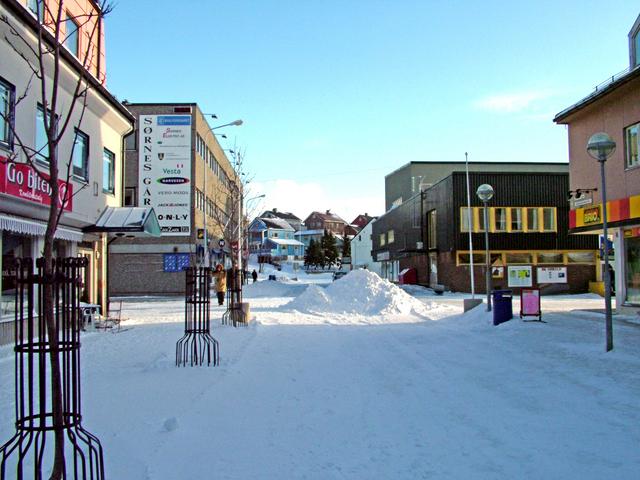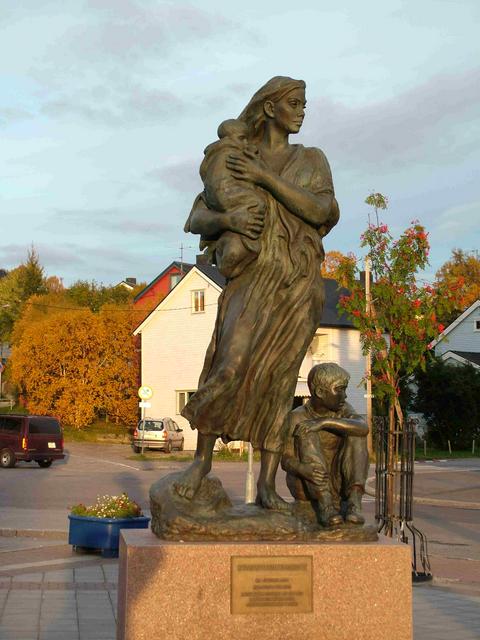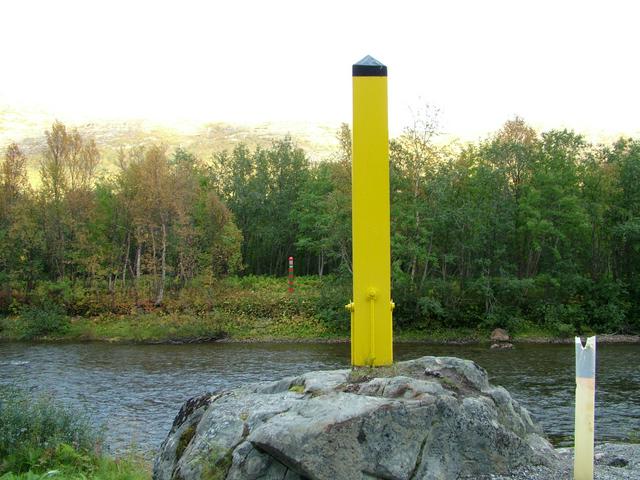Kirkenes is a town in the Finnmark region of Norway, far east near the Russian border, more or less in the end of mainland Norway. This is the last port for Hurtigruten and the end of Norway's main road E6, 2500 km from Oslo and 3120 km from Trelleborg (Sweden).

The region was Germany's staging ground for its northern front against the Soviet Union during World War II, and this has left marks in the area. The town of Kirkenes was totally destroyed by almost 350 Soviet air raids, and holds the record as the most bombed-out town in Europe during the war. Upon an imminent Soviet advance the population was forced by the Germans to relocate to Tromsø and further south. However, more than 3,000 residents and their livestock hid for around ten days in the mines and appeared when the town was liberated by the Red Army in October 1944, more than six months ahead of Norway as a whole. Norway's flag was raised on liberated territory for the first time at the Kirkenes mines. The buildings at the mines were the only ones remaining, and the first administration in free Norway was set up there.
Kirkenes is also known as a mining town, and mining for iron ore has been taken up again after a hiatus. Kirkenes has some 3,500 inhabitants.
-kbYNa.medium.jpg) The mother of US actor René Zellweger was born and grew up in Kirkenes. Her parents met at the Hurtigruten ferry.
The mother of US actor René Zellweger was born and grew up in Kirkenes. Her parents met at the Hurtigruten ferry.
The municipal tourist information is at the public library downtown.

- The midnight sun in summer
- The Aurora Borealis in winter
- The Russian border, including the three-borders-mark., where also Finland joins in. Caution should be exercised; presume all movement is under surveillance near the border. It is allowed to go almost to the border on the Norwegian side, but not the Russian. Respect the border and border zone as if we still had the cold war (e.g. long lens use is restricted, talking over the border forbidden except in emergencies). The easiest place to reach the border is Skafferhullet., signposted from road E105. The three-borders-mark is in the Pasvik–Inari Trilateral Park, see below.
- Grenselandmuseet, Førstevannslia, +47 78 994880. 9.30-14.00 (20.6-31.8: 9.30-17.00). Showcases history and lifestyle of the far north of Norway including a section devoted to the devastating effects of Second World War on Kirkenes. Also has a fine exhibition of woodcuts by the Sami artist Jon Savio Entrance NOK 80/60,-.
- Ä´vv Skolt Sámi museum, Neiden (40km drive from Kirkenes. A museum about Eastern / Skolt Sámi people. First opened in June 2017. Adults: kr 80, Pensioner: kr 60, Groups 10+: kr 60 per pers, Children under16: free entrance.
The Russian border, including the three-borders-mark., where also Finland joins in. Caution should be exercised; presume all movement is under surveillance near the border. It is allowed to go almost to the border on the Norwegian side, but not the Russian. Respect the border and border zone as if we still had the cold war (e.g. long lens use is restricted, talking over the border forbidden except in emergencies). The easiest place to reach the border is Skafferhullet., signposted from road E105. The three-borders-mark is in the Pasvik–Inari Trilateral Park, see [[#Go next|below]].
The Russian border, including the three-borders-mark., where also Finland joins in. Caution should be exercised; presume all movement is under surveillance near the border. It is allowed to go almost to the border on the Norwegian side, but not the Russian. Respect the border and border zone as if we still had the cold war (e.g. long lens use is restricted, talking over the border forbidden except in emergencies). The easiest place to reach the border is Skafferhullet., signposted from road E105. The three-borders-mark is in the Pasvik–Inari Trilateral Park, see [[#Go next|below]].
Grenselandmuseet, Førstevannslia, +47 78 994880. 9.30-14.00 (20.6-31.8: 9.30-17.00). Showcases history and lifestyle of the far north of Norway including a section devoted to the devastating effects of Second World War on Kirkenes. Also has a fine exhibition of woodcuts by the Sami artist Jon Savio Entrance NOK 80/60,-.
Ä´vv Skolt Sámi museum, Neiden (40km drive from Kirkenes. A museum about Eastern / Skolt Sámi people. First opened in June 2017. Adults: kr 80, Pensioner: kr 60, Groups 10+: kr 60 per pers, Children under16: free entrance.
Fishing, both salt and fresh water, including salmon. Hiking.
- Arctic Adventure. A number of offers, the most desired being a King Crab Safari, catch guaranteed!
- Local summer festival Kirkenes Days around the first week of August multiplies the activity level.
- Kirkenes Snow Hotel, +47 78-970-540. The hotel is open from December to early April. A range of activities, some of which vary by the season (you do not have to stay at the hotel to participate): king crab excursions, including catching and eating, husky tours, reindeer watching.
- Øvre Pasvik National Park, +47 46-41-36-00. The largest area of primeval forest in Norway, part of the Russian taiga. Forested hills, lakes and bogs. Also eastern species seldom seen in western Europe. Bears. A few open wilderness huts, wild camping allowed. The Piilola trail has information boards telling about the nature and cultural history of the area, and continues through Vätsäri Wilderness Area in Finland. The visitor centre (nasjonalparksentre) is in Svanhovd, Svanvik, and features also a botanic garden, best visited in Jul-Aug.
Arctic Adventure. A number of offers, the most desired being a King Crab Safari, catch guaranteed!
Kirkenes Snow Hotel, +47 78-970-540. The hotel is open from December to early April. A range of activities, some of which vary by the season (you do not have to stay at the hotel to participate): king crab excursions, including catching and eating, husky tours, reindeer watching.
Øvre Pasvik National Park, +47 46-41-36-00. The largest area of primeval forest in Norway, part of the Russian taiga. Forested hills, lakes and bogs. Also eastern species seldom seen in western Europe. Bears. A few open wilderness huts, wild camping allowed. The Piilola trail has information boards telling about the nature and cultural history of the area, and continues through Vätsäri Wilderness Area in Finland. The visitor centre (nasjonalparksentre) is in Svanhovd, Svanvik, and features also a botanic garden, best visited in Jul-Aug.
-JIsbe.medium.jpg) Russian visitors often buy clothes and home products, which tax-free are cheaper than similar non-Russian products in nearby Murmansk or Nikel. Spareland is a popular shop for this. Information about taxfree (only for non-EU/Norwegian residents) refunds are available at globalblue.com.
Russian visitors often buy clothes and home products, which tax-free are cheaper than similar non-Russian products in nearby Murmansk or Nikel. Spareland is a popular shop for this. Information about taxfree (only for non-EU/Norwegian residents) refunds are available at globalblue.com.
Local Norwegians can get a 5-year multitravel visa and they like to go to Russia to buy petrol (less than half the price) and some Russian products and services. They are not allowed to bring meat over the border, and alcohol only if they been in Russia for 24 hours (and then only a small quota), products which otherwise are the most bought by Norwegians in the border trade in Sweden and Finland. Visitors need a visa which is costly and tricky to get.
Being a small settlement dining opportunities are not abundant. There are however a few restaurants.
- Ritz, Dr. Wessels gate 17, +47 78 99 34 81.
- Surf & Turf, Dr. Wessels gate 2, +47 464 45 245.
Ritz, Dr. Wessels gate 17, +47 78 99 34 81.
Surf & Turf, Dr. Wessels gate 2, +47 464 45 245.
Try Ritz or Ofelas.
- Go up the Pasvik valley for quite a change of flora. Here you find the last bit of the enormous Russian Taiga, a pine forest that stretches all the way to Siberia. At the southern end of the valley (105 km of paved road, 15 km of dirt, then 1h15m walking along the Russian border) is the Tri-Border Mark, where Norway, Russia and Finland meet. Heavy fines for trespassing into Russia! The Pasvik-Inari trilateral park, including areas with different protection status in the three countries, features much untamed wilderness, but also some services and cultural attractions.
- At Grense Jakobselv (58 from Kirkenes), the open Barents Sea washes a beautiful sandy shore. Never gets above 8°C, though! You can also peek at the "King Oscar II" church.
- The highest peak around is "Øretoppen", at 466 metres. It is a 2-hour hike along a marked path from Ropelv, where buses go. Magnificent views in a landscape of large stones spread upon the hills.

- If you plan on crossing the border into Russia, you will probably need a visa. In theory, this should be obtainable at the Russian Consulate in Kirkenes, but you might find it worthwhile to pay any local travel agency a little extra for the job. You need quite a few documents, especially if you are using car, like paid a hotel booking and insurance forms. Start the process one month before leaving home.
- If you are heading for Finland, and feel that you need some euros, there is an ATM at the DnB bank that will hand them over. The route by foot straight through the forest to the Finnish side is possible for experienced wilderness backpackers (Piilola trail, 35 km from Sortbryststjern to Kessintie, unless you want to find your own routes; clear with customs beforehand if needed); sleep in huts on the way and arrange somebody to fetch you with taxi or boat (over Lake Inari) from there or from Nellim, to Ivalo or Inari. Sortbryststjern is on the road towards the tripoint, some 25 km before the tripoint. There is no marked trail from the tripoint itself, and the shortest route from there is blocked by the border zone. The nearest border crossings for vehicles are at Neiden/Näätämö and Nuorgam.
- Alternatively, if your travel budget allows, you can take the Hurtigruten cruise ferry to your destination of choice along the Norwegian coast. A trip to Bergen will take a full week, to places like Nordkapp, Tromsø, Lofoten or Trondheim a couple of days.
If you plan on crossing the border into [[Russia]], you will probably need a visa. In theory, this should be obtainable at the Russian Consulate in Kirkenes, but you might find it worthwhile to pay any local travel agency a little extra for the job. You need quite a few documents, especially if you are using car, like paid a hotel booking and insurance forms. Start the process one month before leaving home.
If you are heading for [[Finland]], and feel that you need some euros, there is an ATM at the DnB bank that will hand them over. The route by foot straight through the forest to the Finnish side is possible for experienced wilderness backpackers (Piilola trail, 35 km from Sortbryststjern to Kessintie, unless you want to find your own routes; clear with customs beforehand if needed); sleep in huts on the way and arrange somebody to fetch you with taxi or boat (over Lake Inari) from there or from Nellim, to [[Ivalo]] or [[Inari]]. Sortbryststjern is on the road towards the tripoint, some 25 km before the tripoint. There is no marked trail from the tripoint itself, and the shortest route from there is blocked by the border zone. The nearest border crossings for vehicles are at [[Neiden]]/[[Näätämö]] and [[Nuorgam]].
Go up the Pasvik valley for quite a change of flora. Here you find the last bit of the enormous Russian Taiga, a pine forest that stretches all the way to Siberia. At the southern end of the valley (105 km of paved road, 15 km of dirt, then 1h15m walking along the Russian border) is the Tri-Border Mark, where Norway, Russia and Finland meet. Heavy fines for trespassing into Russia! The Pasvik-Inari trilateral park, including areas with different protection status in the three countries, features much untamed wilderness, but also some services and cultural attractions.
At Grense Jakobselv (58 from Kirkenes), the open Barents Sea washes a beautiful sandy shore. Never gets above 8°C, though! You can also peek at the "King Oscar II" church.
